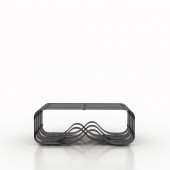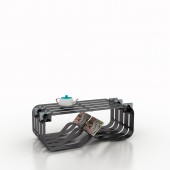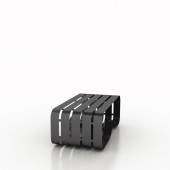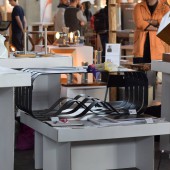
| THE AWARD |
| CATEGORIES |
| REGISTRATION |
| SUBMIT YOUR WORK |
| ENTRY INSTRUCTIONS |
| TERMS & CONDITIONS |
| PUBLICATIONS |
| DATES & FEES |
| METHODOLOGY |
| CONTACT |
| WINNERS |
| PRESS ROOM |
| GET INVOLVED |
| DESIGN PRIZE |
| DESIGN STORE |
| THE AWARD | JURY | CATEGORIES | REGISTRATION | PRESS | WINNERS | PUBLICATIONS | ENTRY INSTRUCTIONS |
Arctic Coffee Table by Wai Ho Cheung |
Home > Winners > Design #50628 >Interview |
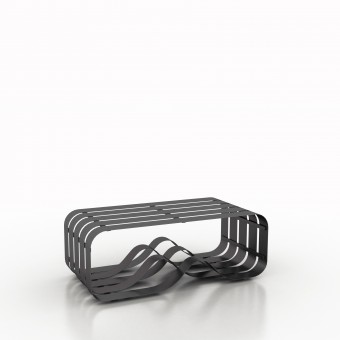 |
|
FS: What is the main principle, idea and inspiration behind your design?
WC: The form is inspired by tidal wave. In the meantime, the functionality is inspired by park bench slats.
FS: What has been your main focus in designing this work? Especially what did you want to achieve?
WC: The main focus was to improve the first version I did and turn it into more commercial. Therefore, my aim was to design a unique coffee table with material and production process as cheap as possible.
FS: What are your future plans for this award winning design?
WC: I will try to sell the design to a furniture company.
FS: How long did it take you to design this particular concept?
WC: I took around a week to design the first version, as the first version was for publishing related to Fuorisalone 2016, Milan. Then I redesigned and finished the current version in a week after the event, which took around a month for the whole design process discretely.
FS: Why did you design this particular concept? Was this design commissioned or did you decide to pursuit an inspiration?
WC: I wanted to apply for the selection of a catalogue, Design for 2016 with new designs. Therefore, I created the first version, Wave ( (Please visit http://waihocheung.wixsite.com/waihocheung/wave for detail regarding the design). Afterwards, I wanted to develop the previous one into a more commercial way. Thus, Arctic was designed.
FS: Is your design being produced or used by another company, or do you plan to sell or lease the production rights or do you intent to produce your work yourself?
WC: It has not been produced or used by any company yet, only a prototype was produced by myself. However, I would like to sell the production rights to a furniture company.
FS: What made you design this particular type of work?
WC: I am highly committed to developing a career in furniture design. Therefore, I always develop self-directed projects to fulfil my desire and to put my design concept and philosophy into practice.
FS: Where there any other designs and/or designers that helped the influence the design of your work?
WC: Unfortunately, there was no other designer got influence.
FS: Who is the target customer for his design?
WC: The target customers would be people who love furniture in simple and contemporary style.
FS: What sets this design apart from other similar or resembling concepts?
WC: I would say the simple and economy production process, under-estimated functionality and unique outlook with the dynamic waves are the factors set apart this coffee table from others.
FS: How did you come up with the name for this design? What does it mean?
WC: The current version was called Uphill originally. However, I thought the waves underneath looked like currents in ocean more than hills. Besides, in Chinese Five Elements, the corresponding colour and direction to Water element are black and north. Therefore, I renamed it as the largest ocean in the north, Arctic.
FS: Which design tools did you use when you were working on this project?
WC: I used pencils, AutoCAD, 3ds Max, my brain and my heart.
FS: What is the most unique aspect of your design?
WC: Certainly, it would be the dynamic waves underneath which can generate a visual illusion that the still table appears as moving.
FS: Who did you collaborate with for this design? Did you work with people with technical / specialized skills?
WC: From idea development to building up CAD model, I worked on my own at each stage and I appreciate Mr. Ip’s assist by giving technical advice.
FS: What is the role of technology in this particular design?
WC: I would say that technology will be only involved during the production. This design does not contain any high technology.
FS: Is your design influenced by data or analytical research in any way? What kind of research did you conduct for making this design?
WC: My design is not exactly influenced by any analytical research, just my limited knowledge of science and knowledge of I Ching (易經).
FS: What are some of the challenges you faced during the design/realization of your concept?
WC: The first version was designed with 3 types of materials, so the challenge was to reduce the types of material used, at the same time to keep the dynamic outlook and to emphasise it.
FS: How did you decide to submit your design to an international design competition?
WC: I met a Dutch designer who won the gold award at A' Design and he recommended me to apply for it.
FS: What did you learn or how did you improve yourself during the designing of this work?
WC: The first version was an asymmetric design with one end opened; now Arctic is a combination with symmetric and asymmetric design elements, depends on the point of view.
FS: Any other things you would like to cover that have not been covered in these questions?
WC: It is a complete questionnaire. For more information, please feel free to request an interview.
FS: Thank you for providing us with this opportunity to interview you.
A' Design Award and Competitions grants rights to press members and bloggers to use parts of this interview. This interview is provided as it is; DesignPRWire and A' Design Award and Competitions cannot be held responsible for the answers given by participating designers.
| SOCIAL |
| + Add to Likes / Favorites | Send to My Email | Comment | View Press-Release | Translations |
